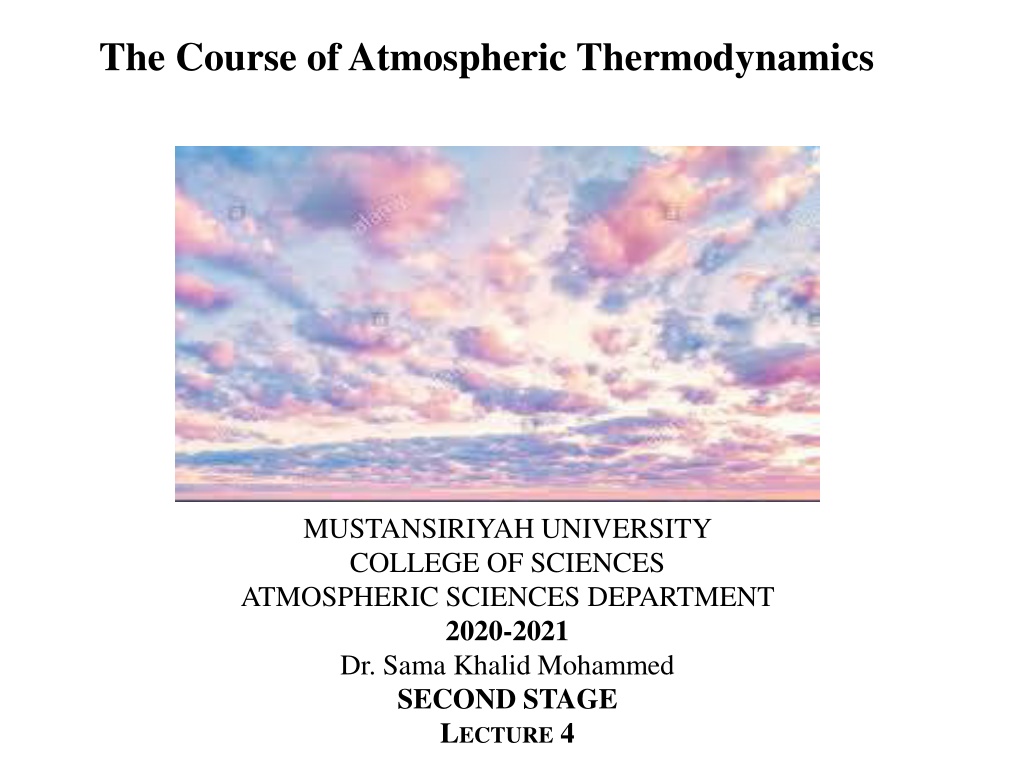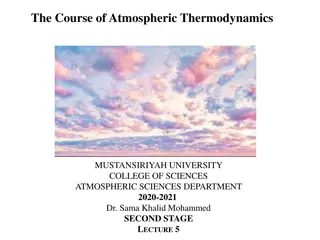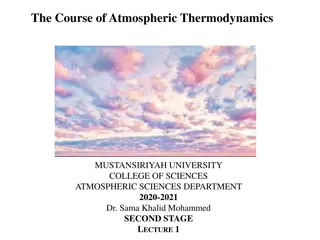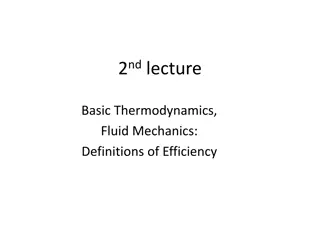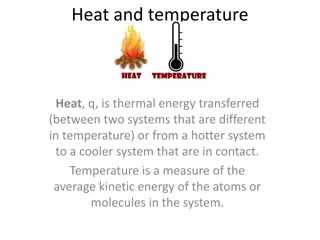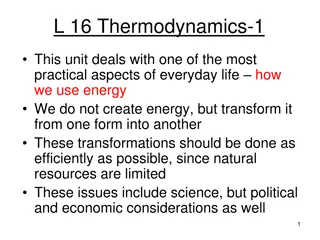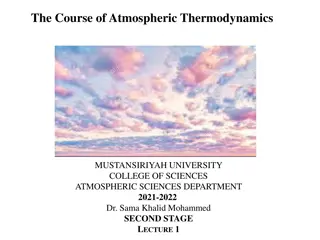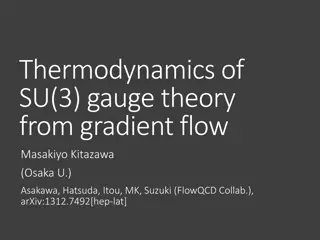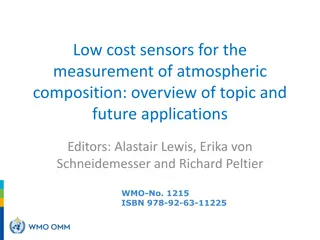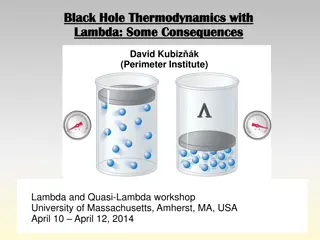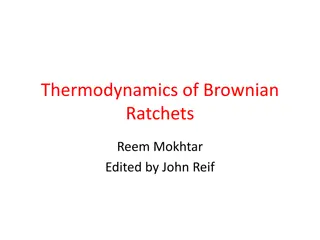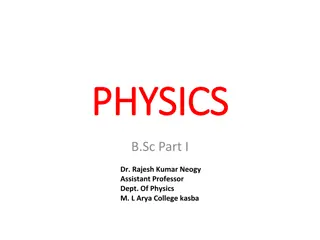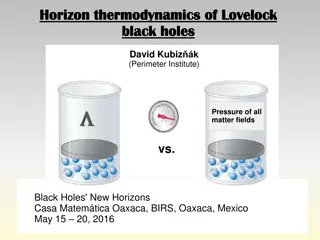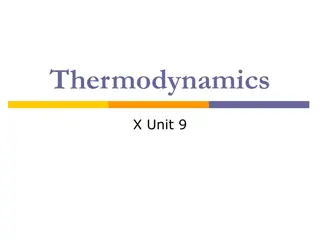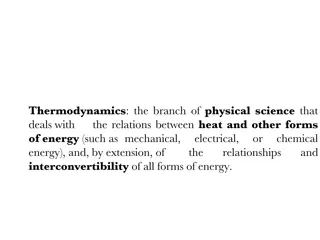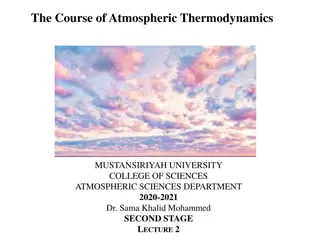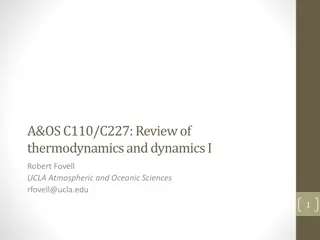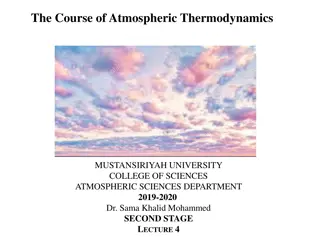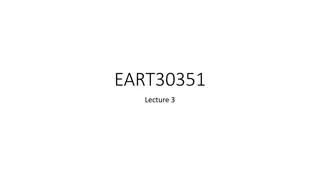Atmospheric Thermodynamics: Key Concepts and Applications
Exploring the principles of atmospheric thermodynamics in a lecture by Dr. Sama Khalid Mohammed at Mustansiriya University. Topics covered include air parcel behavior, relative humidity definitions, and factors affecting humidity levels. Gain insights into saturation, supersaturation, and how temperature and water vapor content influence relative humidity.
Download Presentation

Please find below an Image/Link to download the presentation.
The content on the website is provided AS IS for your information and personal use only. It may not be sold, licensed, or shared on other websites without obtaining consent from the author. Download presentation by click this link. If you encounter any issues during the download, it is possible that the publisher has removed the file from their server.
E N D
Presentation Transcript
The Course of Atmospheric Thermodynamics MUSTANSIRIYAH UNIVERSITY COLLEGE OF SCIENCES ATMOSPHERIC SCIENCES DEPARTMENT 2020-2021 Dr. Sama Khalid Mohammed SECOND STAGE LECTURE 4
THIS LECTURE INCLUDING THE FOLLOWING ITEMS What is happening to the air parcel since it start to move upward? What will happen if the air parcel was dry or moist, but not saturated? What will happen if the air parcel was saturated? In order to answer those questions, we need to use the thermodynamic expressions we have take in the previous lectures, in addition to thermodynamic charts.
Think & Answer When does the air is called unsaturated, saturated, supersaturated? Air with a 50 percent relative humidity actually contains one- half the amount required for saturation. Air with a 100 percent relative humidity is said to be saturated because it is filled to capacity with water vapor. Air with a relative humidity greater than 100 percent is said to be supersaturated.
Think & Answer A change in relative humidity can be brought about in two primary ways, what are they? by changing the air s water vapor content 2. by changing the air temperature
Think & Answer As water vapor is added to the air (with no change in air temperature), the relative humidity increases, and, as water vapor is removed from the air, the relative humidity lowers. If the air temperature remains constant, an increase in the air s water vapor content increases the air s actual vapor pressure and raises the relative humidity. The relative humidity increases as the actual vapor pressure approaches the saturation vapor pressure and the air approaches saturation
Think & Answer with no change in water vapor content, an increase in air temperature lowers the relative humidity, while a decrease in air temperature raises the relative humidity. A change in the air temperature can bring about a change in the relative humidity because a change in air temperature alters the air s saturation vapor pressure. If the air temperature increases, the saturation vapor pressure also increases, which raises the air s water vapor capacity. If there is no change in the air s actual water vapor content, the relative humidity lowers. If, the air temperature decreases, so does the air s saturation vapor pressure. As the saturation vapor pressure approaches the actual vapor pressure, the relative humidity increases as the air approaches saturation.
Think & Answer A rising parcel of air .(compressed / expands) and cools, while a sinking parcel is (compressed / expands) and warms. When an air parcel rises, it moves into a region where the air pressure surrounding it is lower. This situation allows the air molecules inside to push outward on the parcel walls, expanding it. As the air parcel expands, the air inside cools. If the same parcel is brought back to the surface, the increasing pressure around the parcel squeezes (compresses) it back to its original volume, and the air inside warms. Hence, a rising parcel of air expands and cools, while a sinking parcel is compressed and warms.
Think & Answer If a parcel of air expands and cools, or compresses and warms, with no interchange of heat with its outside surroundings, this situation is called an .(isothermal/isobaric/isochoric/adiabatic) Process . If a parcel of air expands and cools, or compresses and warms, with no interchange of heat with its outside surroundings, this situation is called an adiabatic process .
Think & Answer Addition of water vapor to the air increases the dew point; removing water vapor lowers it, is that true??? Td represents the temperature to which air would have to be cooled (with no change in air pressure or moisture content) for saturation to occur. High dew points indicate high water vapor content; low dew points, low water vapor content. Addition of water vapor to the air increases the dew point; removing water vapor lowers it.
Think & Answer The dew point depression DD can indicate whether the relative humidity is low or high. When DD is high(meaning the air temperature and dew point are far apart), the relative humidity is . (high/low). When the air temperature and dew point are far apart, the relative humidity is low; when they are close to the same value, the relative humidity is high. When the air temperature and dew point are equal, the air is saturated and the relative humidity is 100 percent. Even though the relative humidity may be 100 percent, the air, under certain conditions, may be considered dry.
Think & Answer why polar air is often described as being dry when the relative humidity is high (often close to 100 percent) In cold, polar air, the dew point and air temperature are normally close together. But the low dew-point temperature means that there is little water vapor in the air. Consequently, the air is dry even though the relative humidity is high.
Think & Answer The desert air, with a large separation between air temperature and dew point, has a much lower relative humidity than polar air, Explain The desert air, with a large separation between air temperature and dew point, has a much lower relative humidity,(16%). However, since dew point is a measure of the amount of water vapor in the air, the desert air (with a higher dew point) must contain more water vapor. So even though the polar air has a higher relative humidity, the desert air that contains more water vapor has a higher water vapor density, or absolute humidity. (The specific humidity and mixing ratio are also higher in the desert air.)
Think & Answer Define the saturation mixing ratio The saturation mixing ratio (ws) is the ratio of the mass of water vapor (Mv) to the mass of dry air (Md) in a parcel of air at saturation. In other words ws is the maximum amount of water vapor that a parcel can hold without condensation. ws = Mv / Md The saturation mixing ratio is expressed in grams of water vapor per kilogram of dry air.
Think & Answer Discuss the following statement Relative Humditiy tells us how close an air parcel is to saturation( It does not directly tell us how much water vapor is in the parcel!), a parcel with higher relative humidity may actually have less water vapor than another parcel with lower relative humidity Use the equation of relative humidity to find the answer
Think & Answer The air temperature in a rising parcel of unsaturated air decreases at the .. adiabatic rate (dry/moist) As long as the air in the parcel is unsaturated (the relative humidity is less than 100 percent), the rate of adiabatic cooling or warming remains constant and is about 10 C for every 1000 meters of change in elevation, Since this rate of cooling or warming only applies to unsaturated air, it is called the dry adiabatic rate
Think & Answer The air temperature in a rising parcel of saturated air decreases at the .(dry/moist) adiabatic rate. As the rising air cools, its relative humidity increases as the air temperature approaches the dew-point temperature. If the air cools to its dew-point temperature, the relative humidity becomes 100 percent. Further lifting results in condensation, a cloud forms, and latent heat is released into the rising air. Because the heat added during condensation offsets some of the cooling due to expansion, the air no longer cools at the dry adiabatic rate but at a lesser rate called the moist adiabatic rate.
Think & Answer What does that means? and which one has a higher value? The dry adiabatic rate and moist adiabatic rate of cooling are different due to the fact that latent heat is released in a rising parcel of saturated air . Because latent heat is added to the rising saturated air, the process is not really adiabatic. If a saturated parcel containing water droplets were to sink, it would compress and warm at the moist adiabatic rate because evaporation of the liquid droplets would offset the rate of compressional warming. Hence, the rate at which rising or sinking saturated air changes temperature the moist adiabatic rate is less than the dry adiabatic rate.
Think & Answer In a stable atmosphere, a lifted parcel of air will be (colder/warmer) and .(lighter/heavier) than the air surrounding it. Because of this fact, the lifted parcel will tend to sink back to its original position. In a stable atmosphere, a lifted parcel of air will be colder and heavier than surrounding it. Because of this fact, the lifted parcel will tend to sink back to its original position. the air
Think & Answer In an unstable atmosphere, a lifted parcel of air will be ..(colder/warmer) and .. (lighter/heavier) than the air surrounding it, and thus will continue to rise upward, away from its original position. In an unstable atmosphere, a lifted parcel of air will be warmer and lighter than surrounding it, and thus will continue to rise upward, away from its original position. the air
Think & Answer The atmosphere becomes more (stable/unstable) as the surface air cools or the air aloft warms. The atmosphere becomes more stable as the surface air cools, or the air aloft warms.
Think & Answer The atmosphere becomes more (stable/unstable) as the surface air warms, or the air aloft cools. The atmosphere becomes more unstable as the surface air warms, or the air aloft cools.
Think & Answer The atmosphere is stable when the environmental lapse rate is . (small/large); that is, when there is a relatively small difference in temperature between the surface air and the air aloft. The atmosphere is stable when the environmental lapse rate is small; that is, when there is a relatively small difference in between the surface air and the air aloft. temperature
